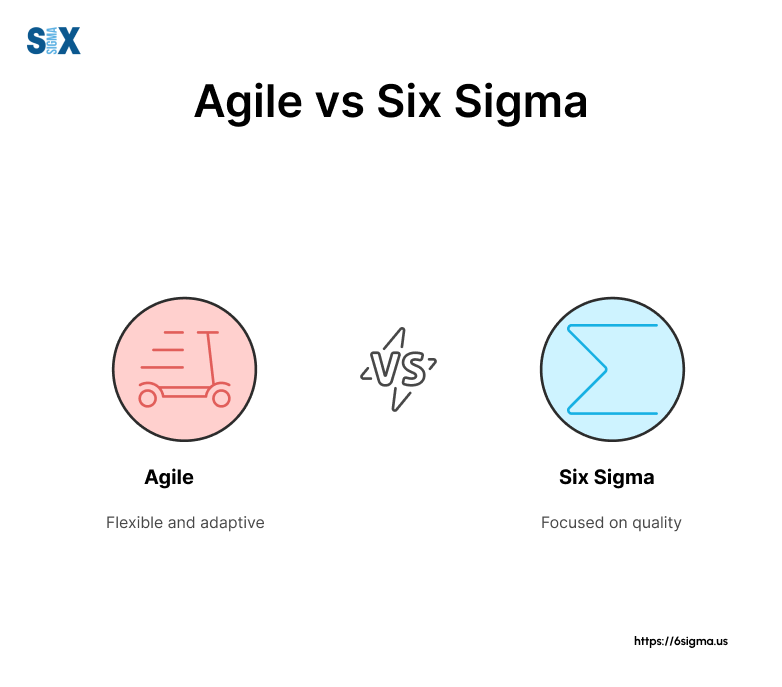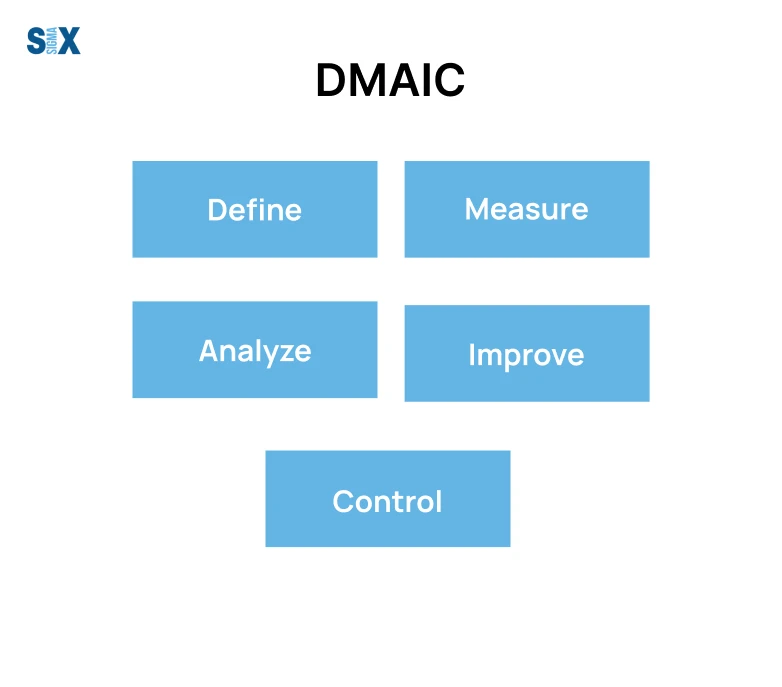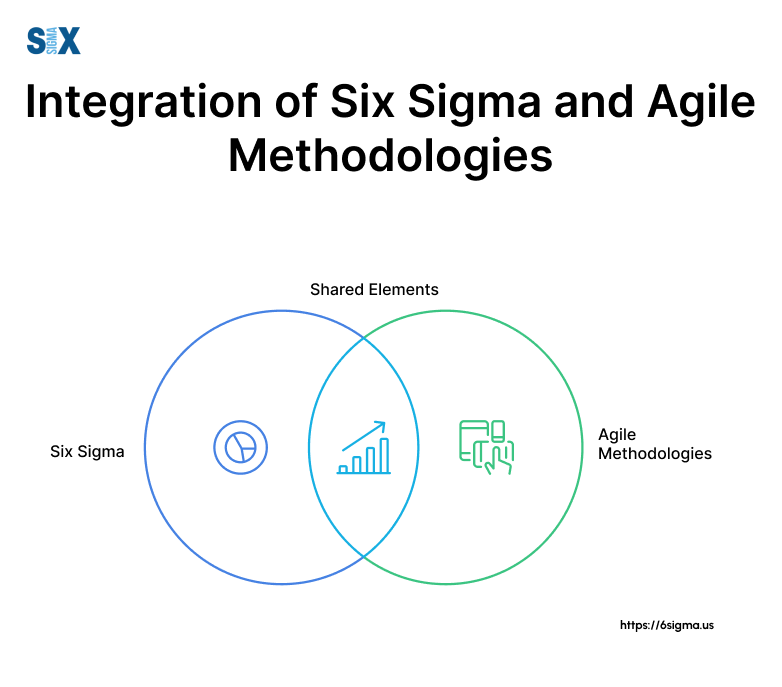Six Sigma vs Agile: Which Approach is Best for Your Organization?
Two methodologies that have gained significant traction are Six Sigma and Agile.
While both aim to enhance efficiency and deliver value, they take distinctly different paths to achieve these goals.
Six Sigma, rooted in statistical analysis and process improvement, focuses on reducing defects and variability.
On the other hand, Agile, born from the software development world, emphasizes flexibility, collaboration, and iterative progress.
Key Highlights
- Evolution of project management and process improvement methodologies
- DMAIC framework and statistical analysis in Six Sigma
- Agile Manifesto principles and Scrum methodology overview
- Customer-centric strategies in Six Sigma and Agile
- Implementing cross-functional teams and change management strategies
- Assessing organizational goals for methodology selection
Introduction to Process Improvement Methodologies
Organizations are constantly seeking ways to enhance their operations and deliver better results.
This section explores the evolution of project management approaches and introduces two powerful methodologies: Six Sigma and Agile.

The Evolution of Project Management Approaches
Project management has come a long way since its inception.
Traditional methods, often characterized by rigid planning and linear execution, have given way to more flexible and adaptive approaches.
This shift has been driven by the need for organizations to respond quickly to changing market conditions and customer demands.
The emergence of process improvement methodologies has played a crucial role in this evolution.
These methodologies aim to streamline operations, reduce waste, and enhance overall efficiency.
Among the most prominent of these are Six Sigma and Agile, each offering unique perspectives on how to achieve organizational excellence.
Defining Six Sigma and Agile
Six Sigma and Agile represent two distinct philosophies in the realm of process improvement and project management.
Six Sigma, developed by Motorola in the 1980s, is a data-driven methodology that focuses on reducing defects and variability in processes.
It employs statistical analysis to identify and eliminate sources of errors, aiming to achieve near-perfect quality levels.
The name “Six Sigma” refers to a statistical measure where 99.99966% of all opportunities to produce are statistically expected to be free of defects.
Agile, on the other hand, emerged in the software development industry in the early 2000s. It emphasizes flexibility, collaboration, and rapid iteration.
Agile methodologies break projects into small, manageable chunks called “sprints“, allowing teams to adapt quickly to changes and deliver value incrementally.
The Agile Manifesto, which outlines its core principles, prioritizes individuals and interactions, working software, customer collaboration, and responding to change.
Now, start from the basics with Introduction to Six Sigma and Agile concepts with Lean Six Sigma Yellow Belt
Understanding Six Sigma
Six Sigma is a robust methodology that has revolutionized process improvement across various industries.
The DMAIC Framework Explained
At the heart of Six Sigma lies the DMAIC framework, a structured problem-solving approach that guides practitioners through the improvement process.
DMAIC stands for Define, Measure, Analyze, Improve, and Control.
- Define: In this initial phase, the project goals and customer requirements are clearly identified.
- Measure: This stage involves collecting data to establish current process performance levels.
- Analyze: Here, the data is scrutinized to identify root causes of defects and opportunities for improvement.
- Improve: Solutions are developed and implemented to address the identified issues.
- Control: The final phase focuses on monitoring the improved process to ensure sustained gains.

The DMAIC framework provides a systematic approach to tackling complex problems, ensuring that improvements are data-driven and sustainable.
Statistical Analysis in Six Sigma
Six Sigma relies heavily on statistical analysis to drive decision-making and process improvement.
Key statistical tools used in Six Sigma include:
- Process capability analysis
- Regression analysis
- Design of experiments
- Control charts
- Hypothesis testing
These tools help in identifying process variations, predicting outcomes, and validating improvements.
Six Sigma Certification Levels
Six Sigma employs a belt-based certification system, similar to martial arts.
Each level represents a different degree of expertise and responsibility within Six Sigma projects:
- White Belt: Basic awareness of Six Sigma concepts
- Yellow Belt: Limited involvement in project work
- Green Belt: Assists with data collection and analysis
- Black Belt: Leads problem-solving projects
- Master Black Belt: Coaches Black Belts and Green Belts, develops key metrics
These certifications provide a clear career path for professionals interested in Six Sigma, ensuring a consistent standard of knowledge and skills across organizations.
Focus on Defect Reduction and Quality Control
The primary goal of Six Sigma is to achieve near-perfect quality by reducing defects and variability in processes.
This ambitious target drives organizations to continually refine their processes, leading to significant improvements in quality, customer satisfaction, and operational efficiency.

Exploring Agile Methodologies
Agile methodologies have transformed the landscape of project management, particularly in software development.
This section examines the core principles of Agile and its popular frameworks, highlighting its emphasis on flexibility and collaboration.
The Agile Manifesto Principles
The Agile Manifesto, created in 2001, outlines four key values and twelve principles that guide Agile methodologies.
The four values are:
- Individuals and interactions over processes and tools
- Working software over comprehensive documentation
- Customer collaboration over contract negotiation
- Responding to change over following a plan
These values emphasize the importance of adaptability, teamwork, and customer focus in project management.
The twelve principles further elaborate on these values, providing a framework for implementing Agile practices in organizations.
Scrum Methodology Overview
Scrum is one of the most widely adopted Agile frameworks.
It provides a structured approach to implementing Agile principles in project management.
Key elements of Scrum include:
- Scrum Team: A cross-functional group of professionals working together to deliver the product
- Product Backlog: A prioritized list of features and requirements
- Sprint: A time-boxed period (usually 2-4 weeks) during which a specific set of work is completed
- Daily Scrum: A brief daily meeting to synchronize activities and plan for the next 24 hours
- Sprint Review and Retrospective: Meetings held at the end of each sprint to review progress and identify areas for improvement
Scrum provides a clear structure for implementing Agile principles, making it popular across various industries beyond software development.
Sprint Planning and Iterative Development
Sprint planning is a crucial aspect of Agile methodologies, particularly in Scrum.
It involves the team collaboratively deciding on the work to be completed in the upcoming sprint.
This process ensures that the team focuses on high-priority items and can realistically accomplish the selected tasks within the sprint time-frame.
Iterative development, a cornerstone of Agile, involves breaking the project into small, manageable chunks that can be completed within a single sprint.
This approach allows for frequent reassessment and adjustment of priorities, ensuring that the project remains aligned with changing business needs and customer requirements.
Importance of Retrospectives in Agile
Retrospectives are a critical component of the Agile process, typically held at the end of each sprint.
These meetings provide an opportunity for the team to reflect on their work processes, identifying what went well and what could be improved.
Key benefits of retrospectives include:
- Continuous improvement of team processes
- Enhanced communication and collaboration
- Identification and resolution of obstacles
- Celebration of successes and team achievements
By regularly conducting retrospectives, Agile teams can continuously refine their processes, leading to increased efficiency and better outcomes over time.
Six Sigma vs Agile: Key Differences and Similarities
| Aspect | Six Sigma | Agile |
|---|---|---|
| Customer-Centric Strategies | Focuses on “Voice of the Customer” (VOC) through data collection and analysis. Aims to reduce defects and variations for consistent, high-quality products/services. | Emphasizes direct and frequent customer collaboration throughout development. Encourages rapid prototyping and iterative development for quick adjustments. |
| Decision Making Approach | Relies on data-driven decision making. Uses statistical analysis and quantitative methods. Provides solid, evidence-based foundation but can be time-consuming. | Emphasizes adaptive planning. Prioritizes flexibility and rapid response to change. Decisions based on most recent information, allowing quick pivots. |
| Project Management Style | Aims for standardized, repeatable processes to minimize variation and defects. Establishes consistent methods across the organization. Can limit flexibility and creativity. | Prioritizes flexibility in project management. Acknowledges uniqueness of each project. Encourages adapting processes to specific project needs and openness to change. |
| Continuous Improvement Techniques | Uses DMAIC cycle (Define, Measure, Analyze, Improve, Control). Focuses on identifying and eliminating root causes. Improvements are typically large-scale and data-driven. | Promotes improvement through regular retrospectives and iterative development. Teams constantly reflect on processes and outcomes, making small, incremental improvements with each sprint. |
This table provides a clear, side-by-side comparison of Six Sigma and Agile across four key aspects, making it easy for readers to understand the main differences between the two methodologies.
Learn in detailed comparison of Six Sigma and Agile methodologies with Lean Six Sigma Black Belt
Implementing Six Sigma and Agile in Organizations
Implementing Six Sigma or Agile methodologies can significantly transform an organization’s operations and culture.
Cross-Functional Teams and Collaboration
Both Six Sigma and Agile emphasize the importance of cross-functional teams and collaboration, albeit in different ways:
In Six Sigma, cross-functional teams are often formed to tackle specific process improvement projects.
These teams typically include members from various departments affected by the process, as well as Six Sigma experts (e.g., Black Belts or Green Belts) who guide the improvement efforts.
Agile methodologies, particularly Scrum, rely heavily on self-organizing, cross-functional teams.
These teams are designed to have all the skills necessary to deliver the product, promoting close collaboration and rapid decision-making.
Value Stream Mapping and Kanban Boards
Value Stream Mapping and Kanban boards are tools that can be valuable in both Six Sigma and Agile implementations:
Value Stream Mapping, often associated with Lean Six Sigma, is a visual tool that helps identify waste and inefficiencies in a process.
It maps out all the steps involved in delivering a product or service, from initial concept to delivery to the customer.
This tool can be particularly useful in identifying areas for improvement and streamlining processes.
Kanban boards, while more commonly associated with Agile methodologies, can also be useful in Six Sigma projects.
Change Management Strategies for Adoption
Implementing Six Sigma or Agile methodologies often requires significant changes in organizational culture and processes.
Effective change management is crucial for successful adoption:
- Leadership Support: Secure buy-in from top management and ensure they visibly champion the new methodology.
- Clear Communication: Clearly articulate the reasons for change, expected benefits, and how it will affect employees.
- Training and Education: Provide comprehensive training to all affected employees on the new methodology and tools.
- Pilot Projects: Start with small-scale implementations or pilot projects to demonstrate success and build momentum.
- Continuous Feedback: Establish mechanisms for gathering and acting on employee feedback throughout the implementation process.
- Celebrate Successes: Recognize and celebrate early wins to motivate continued adoption and enthusiasm.
Remember that cultural change takes time. Patience and persistence are key to successfully embedding new methodologies into organizational DNA.
Can Six Sigma and Agile Coexist?
While Six Sigma and Agile have different origins and approaches, they are not mutually exclusive.
In fact, many organizations are finding value in combining elements of both methodologies:
- Lean Six Sigma Agile: This hybrid approach uses Lean Six Sigma tools for process improvement within an Agile framework. For example, a software development team might use Scrum for project management while employing Six Sigma tools to optimize their development processes.
- Agile for Innovation, Six Sigma for Optimization: Some organizations use Agile methodologies for new product development or innovative projects, while applying Six Sigma to optimize existing processes and operations.
- Data-Driven Agile: This approach integrates Six Sigma’s emphasis on data analysis into Agile processes, using metrics and statistical tools to guide sprint planning and retrospectives.
The key to successfully combining methodologies is to understand the strengths of each and apply them where they can add the most value.
It’s not about rigidly adhering to one methodology, but rather about creating a tailored approach that best serves the organization’s needs.

Choosing Between Six Sigma and Agile
Selecting the right methodology for your organization or project is crucial for success.
Assessing Project Requirements and Organizational Goals
The choice between Six Sigma and Agile often depends on the nature of your projects and your broader organizational objectives:
- Project Predictability: If your projects have well-defined requirements and outcomes, Six Sigma’s structured approach may be more suitable. For projects with evolving requirements or uncertain outcomes, Agile’s flexibility could be advantageous.
- Industry and Sector: Manufacturing and process-heavy industries often benefit from Six Sigma’s focus on defect reduction. Software development and creative industries typically align well with Agile methodologies.
- Organizational Culture: Consider your company’s culture. Does it favor data-driven decision-making (Six Sigma) or rapid iteration and flexibility (Agile)?
- Customer Involvement: If frequent customer feedback and collaboration are crucial, Agile might be the better choice. If meeting precise, predefined customer specifications is key, Six Sigma could be more appropriate.
- Time to Market: For projects where rapid delivery is critical, Agile’s iterative approach might be preferable.
Considerations for Software Development Lifecycle
In the context of software development, several factors influence the choice between Six Sigma and Agile:
- Project Scope: Agile is often better suited for projects with evolving requirements or where the end product is not fully defined at the outset. Six Sigma can be valuable for projects with clearly defined outcomes and quality standards.
- Team Size and Structure: Agile methodologies like Scrum work well with small, cross-functional teams. Six Sigma can be applied to larger, more diverse teams across an organization.
- Release Frequency: If frequent releases and continuous deployment are priorities, Agile’s iterative approach aligns well. Six Sigma might be more appropriate for projects with longer development cycles and stringent quality requirements.
- Maintenance and Support: Six Sigma can be particularly useful in optimizing ongoing maintenance and support processes, while Agile can help in rapidly addressing user feedback and implementing improvements.
Impact on Operational Efficiency and Time-to-Market
Both Six Sigma and Agile aim to improve operational efficiency, but their impact on time-to-market can differ:
Six Sigma typically leads to significant improvements in process efficiency and quality over time.
By reducing defects and variability, it can lead to cost savings and increased customer satisfaction.
Agile methodologies, with their focus on iterative development and frequent releases, often result in faster time-to-market for initial product versions.
They allow for quick adjustments based on market feedback, which can be particularly valuable in fast-moving industries. However, the emphasis on speed must be balanced with maintaining quality standards.
Case Studies: Successful Implementations in Various Industries
Real-world implementations can provide valuable insights:
- Manufacturing: General Electric famously used Six Sigma to achieve billions in cost savings and efficiency improvements across its diverse business units.
- Software Development: Spotify’s implementation of Agile methodologies, particularly their “Squads and Tribes” model, has been widely studied for its success in fostering innovation and rapid product development.
- Healthcare: Virginia Mason Medical Center used Lean Six Sigma principles to improve patient safety and reduce costs, demonstrating the methodology’s applicability beyond manufacturing.
- Financial Services: Capital One adopted Agile methodologies to speed up product development and improve customer experiences in the competitive banking sector.
- Hybrid Approach: John Deere combined Lean Six Sigma with Agile methodologies to improve both manufacturing processes and software development for their high-tech agricultural equipment.
These case studies illustrate that successful implementation depends on aligning the chosen methodology with organizational goals, culture, and industry-specific challenges.
The Future of Process Improvement and Project Management
As we look to the future of process improvement and project management, it’s clear that both Six Sigma and Agile methodologies will continue to play significant roles.
Both Six Sigma and Agile are evolving to meet the challenges of modern business environments:
- Digital Transformation: Six Sigma is increasingly being applied to digital processes, helping organizations optimize their digital operations and customer experiences.
- Agile at Scale: Large organizations are adopting scaled Agile frameworks like SAFe (Scaled Agile Framework) to apply Agile principles across entire enterprises.
- Data Analytics and AI: Both methodologies are incorporating advanced data analytics and artificial intelligence to enhance decision-making and process optimization.
- Remote Work: The rise of remote and distributed teams is influencing how both Six Sigma and Agile are implemented, with a greater emphasis on digital collaboration tools and virtual project management.
- Sustainability: There’s a growing focus on applying these methodologies to improve sustainability and reduce environmental impact in business operations.
While Six Sigma and Agile may have different origins and approaches, they share a common goal of improving organizational performance and delivering value to customers.
The future of process improvement and project management lies not in rigidly adhering to one methodology, but in thoughtfully combining approaches, continuously learning, and adapting to meet the unique challenges of each organization and project.
SixSigma.us offers both Live Virtual classes as well as Online Self-Paced training. Most option includes access to the same great Master Black Belt instructors that teach our World Class in-person sessions. Sign-up today!
Virtual Classroom Training Programs Self-Paced Online Training Programs






